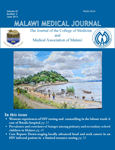
|
Malawi Medical Journal
College of Medicine, University of Malawi and Medical Association of Malawi
ISSN: 1995-7262
Vol. 26, No. 3, 2014, pp. 63-70
|
 Bioline Code: mm14016
Bioline Code: mm14016
Full paper language: English
Document type: Research Article
Document available free of charge
|
|
|
Malawi Medical Journal, Vol. 26, No. 3, 2014, pp. 63-70
| en |
Women empowerment and the current use of long acting and permanent contraceptive: Evidence from 2010 Malawi Demographic and Health Survey
Palamulemi, M. E. & Adebowale, A. S.
Abstract
Background
Both contraceptive use and fertility rates are high fertility in Malawi.
Status of women remains low and is believed to affect reproductive health
decisions including use of Long Acting and Permanent Contraceptives
Method (LAPCM).
Objective
This study seeks to examine the relationship between women empowerment
and LAPCM. A measure of women’s empowerment is derived from the
women’s responses to questions on the number of household decisions in
which the respondent participates, employment status, type of earnings,
women’s control over cash earnings and level of education.
Methods
The study is based on a sub sample of 5,948 married women from the
2010 Malawi Demographic and Health Survey. Data was analysed using
descriptive statistics, Chi-square and multinomial logistic regression
models (α=5%).
Results
The prevalence of current use of LAPCM was 20.0% and increases with
increasing empowerment level (p<0.001). Mean age and empowerment
score of women who are currently using LAPCM were 38.53±6.2 years
and 6.80±2.9 respectively. Urban women (22.2%) were more currently
using LAPCM than rural women (19.4%) p<0.001. Women who belong
to Seven Day Adventists/Baptist were 1.51(C.I=1.058-2.153; p=0.023)
more likely and Muslims were 0.58(C.I=0.410-0.809; p=0.001) less likely
to currently use LAPCM than Catholic women. Being in the richest wealth
quintile (OR=1.91; C.I=1.362-2.665; p<0.001) promotes current use of
LAPCM than poorest. The likelihood of currently using LAPCM was
higher among women who have access to FP programmes on media and
increases consistently with increasing women empowerment level even
when other potential confounding variables were used as control.
Conclusion
In Malawi, LAPCM is still underutilized and more than half of the
women are not adequately empowered. Women empowerment, wealth
quintile and access to FP programmes are key factors influencing the use
of LAPCM. Programmes that address these determinants are urgently
needed in Malawi.
|
| |
© Copyright 2014 - Malawi Medical Journal
Alternative site location: http://revista.uft.edu.br/index.php/jbb/index
|
|
